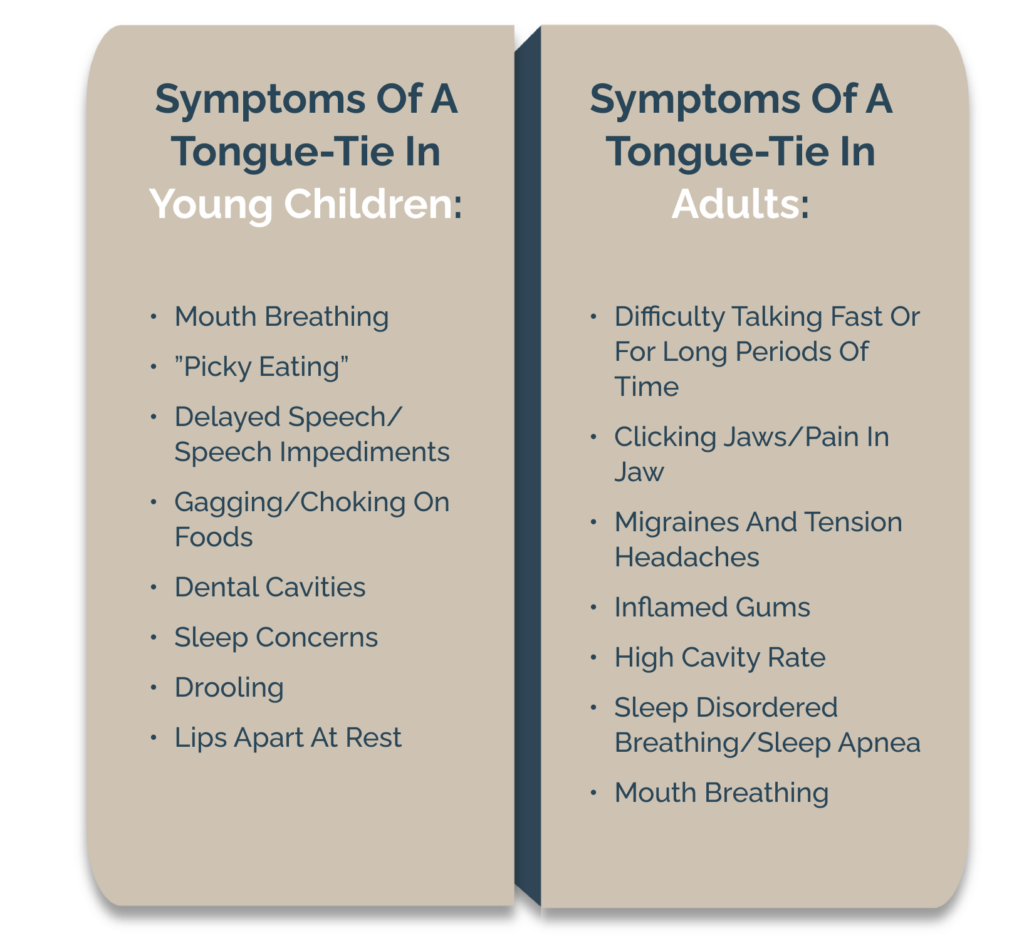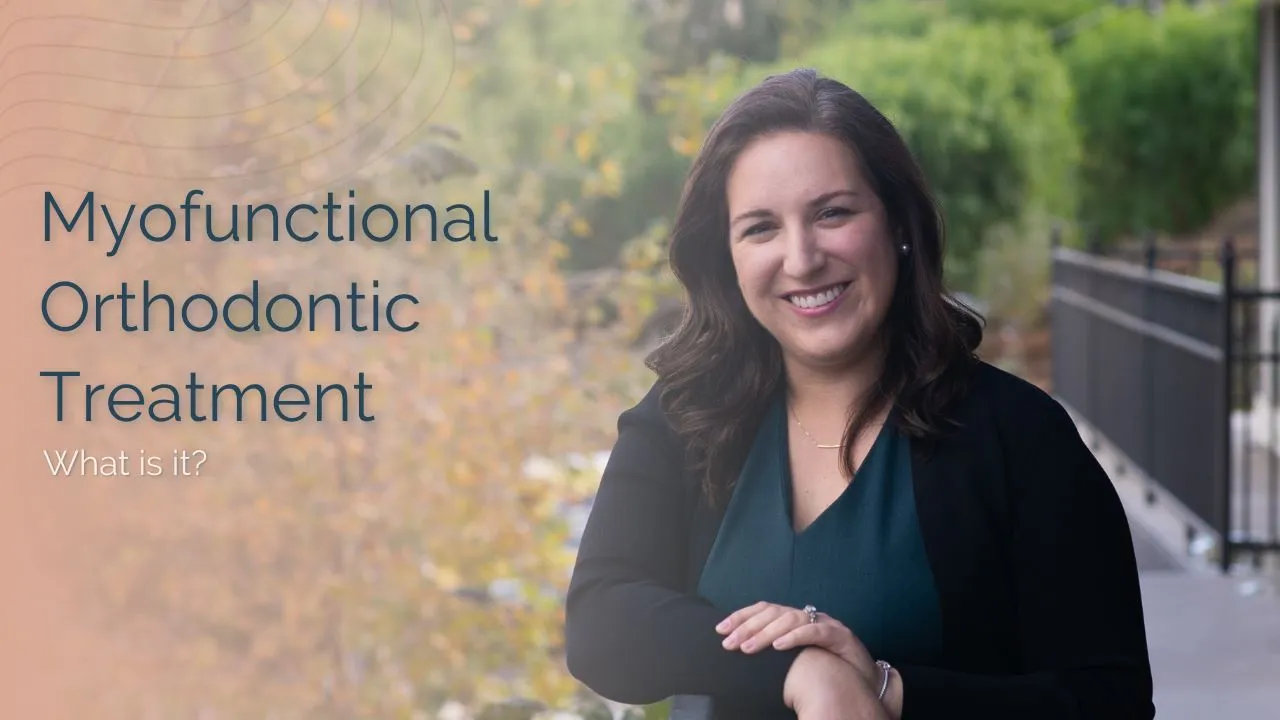LET’S talk ABOUT TONGUE TIES

WHAT ARE THEY AND WHY SHOULD YOU CARE?

During the first years of life, the function of the tongue is essential for the proper development of the jaws, speech, feeding, the alignment of the teeth. It’s very important that parents understand the importance of seeking an in-person initial oral examination for your child. This examination can help detect a tongue-tie or other oral functional issues that may be impacting your child’s growth and development. If a tongue-tie is diagnosed, treatment first involve therapy, which focuses on improving oral muscle function. If additional support is needed beyond therapy, a procedure to release tethered oral tissues may be indicated.
Left untreated, a tongue tie can lead to a number of oral health challenges in adulthood, including difficulties with speech and sleep, as well as increased risk of gum disease, tooth decay and TMJ issues. By working closely with a myofunctional therapist both before and after a procedure, we can ensure our adult patients’ recovery is as smooth and successful as possible. Our myofunctional therapists will help you improve your oral muscle function and flexibility, as well as support you in making any necessary lifestyle changes to maintain good oral health.
Tethered Oral Tissues in Infants
Symptoms of restricted oral tissues in a baby may include:
- Short, shallow, ineffective latch
- Sliding off mom’s nipple
- Prolonged feedings
- Falling asleep while nursing
- Poor weight gain
- Chronic crying episodes
- Colic
- Chronic burping/gas
- Having to feed frequently/baby always seems hungry
- Clicking noises while eating
- Lip curls under during feeding
- Lip blisters
- Reflux
- Milk leaking out of the mouth when feeding
- Baby is frustrated at the breast
Symptoms for mom may include:
- Flattened, bruised, cut or bleeding nipples
- Mastitis/clogged ducts
- Engorged breasts/incomplete drainage
- Low milk supply
HOW DO WE TREAT INFANTS WITH TETHERED ORAL TISSUES?
INFANT FRENECTOMY
Oral Frena are the fibrous attachments of the lips and tongue to the jaws, and they are structures we all have. Everyone’s oral frena are different based on many factors including genetics, epigenetics, nutrition, development, among others. If the oral tissues are restrictive, it can negatively impact feeding early in life. Healthy tongue function is vital to infant feeding, sleeping, and growth, so identifying challenges early on can help get babies off to a good start. By collaborating with a team to help with healthy oral function and body movement, we can help improve infant feeding with a frenectomy when appropriate. This procedure is performed to relieve tension in restrictive oral tissues with a state-of-the-art CO2 laser for increased precision and improved healing. The procedure itself is brief, usually less than 60 seconds, and infants are encouraged to feed immediately afterwards.
The pressure from the tongue during swallow forms the shape of the jaws, and the jaw shape and position dictates how the face and airway will develop. So while infant feeding is important for nutrition, it is also crucial for development, which is why we are so passionate about our work with infants.
Performing a frenectomy is only one aspect of treating tethered oral tissues- we also need to teach the tongue how to move in a new way and release tension in the body. While some may notice an immediate change, usually improvement happens slowly over time when combined with the appropriate therapy.
Tips for your infant frenectomy visit:
- We will have comfortable chairs available, but please bring any pillows or accessories you may need to aid in nursing.
- You will have a private room to nurse.
- Please have an alternate feeding plan available for the initial healing period. While many babies latch and feed right away, it is possible baby may not want to nurse immediately
- Freezing milk in flat 1 oz increments to make breastmilk ice chips can help with wound care/You will be given a small syringe to take home. Having milk stored (either frozen orrefrigerated) to fill the syringe and apply to the site can also help with wound care.
- Ideally baby should come “ready for a snack”. Not starving, and not having just eaten a big meal.
- Have infant Tylenol (or your analgesic of choice) ready at home
Infant Frenectomy FAQs
What is a tongue tie?
A tongue tie, or ankyloglossia, is a condition when the frenum under the baby’s tongue is restricted in its ability to move.
Why does it occur?
A combination of genetic and environmental factors contribute to the occurrence of tongue ties.
Should I see an ENT or dentist?
The tongue is a unique structure that falls in the scope of practice of both Ear Nose and Throat doctors as well as dentists. Both are licensed to treat tethered oral tissues, but more important is their post-graduate training. Tethered oral tissue diagnosis and treatment is not taught in medical or dental school, so providers must seek additional training to be knowledgeable in this area.
Those performing the procedure are knowledgeable about the anatomy. How babies feed and use their tongue involves specialties like Speech Pathologists, Lactation Consultants, and Occupational Therapists. Both are important in achieving best results.
What do you use for the procedure?
We utilize state of the art CO2 light scalpel laser technology.
How long is the procedure?
The procedure lasts a few seconds, and your baby will be with our team for a few brief minutes in total.
What is the ideal time to have a release?
This varies by patient, as feeding concerns may not surface until later in infancy. Ideally, we see patients during the newborn phase, less than 3 months old. However, we treat babies up to 1 year.
Tethered Oral Tissues In Children & Adults

HOW DO WE TREAT CHILDREN & ADULTS WITH TETHERED ORAL TISSUES?
FRENULOPLASTY

A frenuloplasty is a procedure performed to remove large, tight, or poorly positioned band(s) of tissue inside the mouth, connected to the lip, cheeks or floor of the mouth (frenum). Once the tissue has been removed, the area will be sutured. These restrictions are commonly referred to as being “tongue-tied” or “ankyloglossia”, but can be found in cheeks, lips or tongue, and we refer to them as “tethered oral tissues” or TOTs.
This procedure may be performed to improve eating, swallowing, mouth breathing, or myofunctional habits.
Frenuloplasty is a quick procedure, generally taking less than 45 minutes, and is often performed with just local anesthesia in adults and children.

MYOFUNCTIONAL THERAPY
Myofunctional therapy is an important aspect of both pre- and post-operative care for a functional frenuloplasty procedure. Before the surgery, it helps to prepare the oral and facial muscles for the changes that will occur, reducing the risk of complications and promoting faster recovery. After the procedure, myofunctional therapy helps to retrain the muscles to function in their new, correct position, reducing the risk of relapse and promoting long-term success.
It can help alleviate any discomfort or pain that may occur after the surgery and improve the overall function and appearance of the oral and facial structures. Myofunctional therapy is a critical component of a comprehensive treatment plan for functional frenuloplasty, helping to ensure optimal results and improved oral health.
CONSQEUENCES OF untreated
TONGUE-TIES
Infants
- Inefficient feeding
- Poor weight gain
Children
- Increased risk of cavities
- Dental crowding, more narrow jaws
- Vertical facial development, leading to a more narrow airway
- Poor sleep quality, which can lead to poor performance in school/sports/behavior
- Speech delays/difficulties
- Mouth breathing
Adults
- Crowded teeth, narrow jaws
- Mouth breathing
- Hyperactive gag reflex
- Snoring
- Unrestful sleep
